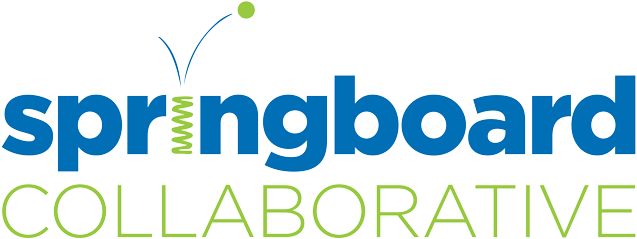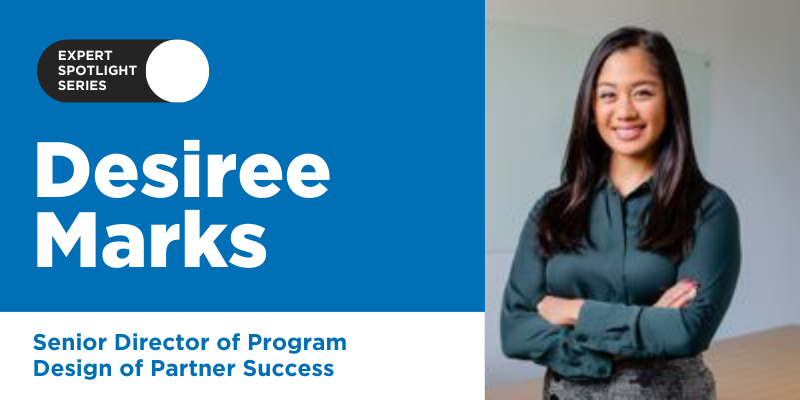As part of our Expert Highlight Series, we get to know, Desiree Marks, Springboard Collaborative’s Senior Director of Partner Success. Desiree believes in transformative experiences for students. As a classroom teacher, she quickly learned that some students required more basic literacy education than she could provide in the course of a school year, which motivated her to seek opportunities for helping students on a broader scale. She is passionate about helping young children build confidence as learners, as well as helping districts, schools, teachers, and families realize their potential in that work.
In this conversation, Desiree talks about helpful characteristics in ideal K-12 afterschool or summer literacy program partners, measuring the impacts of a program’s success, proven strategies for family engagement, and professional development for teachers.
3 Characteristics of a Successful Partnership
Desiree observes that Springboard Collaborative’s most successful partnerships share a few common elements:
“The first commonality is readiness. Our successful partners have cultivated a data-driven culture within their district, even before they partner with Springboard Collaborative. That practice can extend into Springboard Collaborative’s programming, and we can coach leaders and teachers to have honest conversations about scholar reading growth. Is the instruction that we are implementing helping that child grow? What do our family engagement metrics say? A data-driven culture allows for a smoother launch of programs, but also a stronger and more authentic partnership with them.
“Another readiness factor is an openness to consider how we might deepen relationships with families. When we’re working in marginalized communities, there’s often an assumption that families love their kids, but they’re working three jobs or they have a lot of children so they might not be able to attend these meetings. Our successful partners are constantly reframing what the solution could look like within the context of families. And so when we provide a methodology, they are excited to be able to try something new.
“When I visit successful partners, there is joy in the classroom. We most often serve students who are reading below grade level or struggling with reading. Our successful partners have teachers who help students build their confidence. So when you go into these classrooms, you see hands raised, you hear laughter, you see students reading together, you see them engaged when teachers are reading to them, and it’s definitely wonderful to see. And most typically, you see the greatest growth in those schools.”
Family Engagement Through Strong Processes
Desiree is happy to share her strategies for engaging and communicating with families:
“I like to start with figuring out whether districts already have successful ways of engaging and communicating with families. Are they using tools and platforms where they see a higher response rate from families? If so, let’s build on that.
When there haven’t been strong processes set in place, one way to begin family engagement is to partner with other spaces, such as an afterschool program where families are present. We’ve seen embedding our programs into an existing afterschool program as a really great strategy. Students are comfortable, families are familiar, and they’re getting extra literacy instruction or the extra opportunity to learn about how they can support their students at home.
She offers some advice for districts and schools struggling to engage families:
“First, identify what problem you’re trying to solve through increasing family engagement. Then, determine whether the solutions you’re proposing will communicate to families that they are the catalysts versus a barrier. For example, are we thinking about what they can do versus what they can’t? That’s a really important way to frame your problem-solving so that families will feel valued in the process.”
A Literacy Program’s Hidden Professional Development
While literacy programs are first and foremost about the achievements of the students, Desiree notes that implementing these programs can also benefit a teacher’s professional development:
“We love partnering with school districts because we offer professional development for teachers. Literacy programs can help extend teachers’ skillset and build upon their tools and assets to help deepen what they’re doing in the classroom and how they’re contributing to students’ growth. Partnering with literacy programs provides teachers with different ways to deliver instruction. It also provides different instructional resources that can support what they’re currently doing and build upon it. And it also helps them figure out other ways to accelerate the reading growth, such as partnering with families to extend the learning outside of the classroom.”
Staying Centered in the Purpose of Springboard Collaborative
As a part of a mission-driven organization, driving that positive impact on those she is serving is what guides Desiree through her day. She reminds us:
“The most important stakeholders are not our board members or funders. And the purpose of having impact is not just to show that we’re having an impact. The most important thing is that we are helping real people. The students and families at the end of our work always need to be considered and prioritized. So if we really stay centered in the purpose of our work, which is to serve these communities, make students become joyous learners, and help families feel like they are the catalyst in their child’s learning, then we’re doing greater good than we ever anticipated.”
A Book Recommendation for Kids of All Ages
Desiree’s involvement with student literacy makes her think about her own favorite book from childhood:
“The Rainbow Fish by Marcus Pfister resonated with me as a child and now even as an adult because it shares the importance of sharing the special parts of you with others. There was this beautiful fish that had a lot of sparkly scales and didn’t want to share that beauty with other fish but realized that when she did, it actually sparked a lot of joy and happiness around those around her. And so when I think about myself as an educator, a mother, and a person in the world, I like to think about how I can contribute to helping the world be a better place. Whether that’s helping people find their happiness, sharing my joy, or using the professional skills that I have to help make an impact and make the world a better place.”
Like this series? Make sure to follow along on our social media channels (Facebook, Instagram, and LinkedIn) to see all of this information come to life, and follow this tag to see all of the posts in this Expert Highlight Series.


